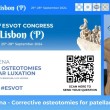 Comparative Orthopaedic Research Surgical Facility (CORe), School of Medicine, Flinders University of South Australia, Australia
Comparative Orthopaedic Research Surgical Facility (CORe), School of Medicine, Flinders University of South Australia, Australia
Q1: You have had considerable experience using sheep as models for exploring the suitability of implants and bone healing adjunctive with the aim of adding particular themes and modems to orthopaedic surgery in mans and animals. Would you please explain your conclusions regarding sheep and their role in research of the nature that you have, and are still, undertaking.
The goal of my research is to ‘model’ human orthopaedic disease as accurately as possible; many surgical procedures closely resemble that performed in the human. For example, cruciate ligament reconstructions are performed arthroscopically.
To these ends the sheep has provided a wonderful modality to achieve the goals we ascribe to. In utilizing this species I am able to model most human orthopaedic issues from total hip replacement, fracture repair and cruciate ligament reconstruction. Unlike the use of other species (canine for example), the sheep enables me to use individuals that are almost genetically identical; this is a major factor in reducing experimental variability. Importantly, we are better able to accommodate the peri-operative needs of the sheep; unlike the dog, they are very social beings in that they actively seek the company of other sheep. We try, where possible, to have a minimalist approach to intervention post-operatively and in so doing substantially reduce the risk of problems associated with overly frequent assessments and handling.
Q2: I know that you have very definite views regarding the care of the animals used in your projects, and have published on the subject.
I am sure that readers will benefit from learning your thoughts and, it is to be hoped, will also enter into discussions about the subject, on this site, within the milieu of veterinary surgery and research.
Historically, I have been appalled at the lack of due-care afforded research animals. I see a major role in what I do as ‘leading-the-way’ for those less well informed individuals who may entertain doing animal-based research.
My sheep do not require a total hip or a cruciate ligament reconstruction. With this basic fact in mind I maximize a pre-emptive approach to pain control and peri-operative care and management of these animals.
Species-specific analgesia over an effective time frame is imperative. This should be combined with a facility that can best handle a given species with minimal impact on the actual animal. At my facility (CORe) we have developed a surveillance/peri-operative care regime that minimizes the stress endured by the animal while maintaining appropriate levels of analgesia. The facility has staged recovery moving initially to a slinging shed in which the sheep are allowed weight bearing but a restricted in their ability to ambulate freely. They can be maintained in this manner for up to three weeks (dependant on the procedure) without complications; usually, the sheep are kept in the sling for a maximum of three days. Thereafter they are moved through increasingly larger pens until finally released to pasture at 3 weeks.
Q3 You have written about some of the techniques that you currently employ in your orthopaedics surgery research. Can you give readers some examples as to how you have applied the techniques to particular problems and what do you anticipate regarding their further use in clinical patient surgery, animal or human?
Radiostereometric analysis (RSA) has, over the last 10 years, become the ‘gold standard’ for measurement of implant wear and migration as it relates to hip and knee prostheses. To date very few RSA studies have or are conducted in animals; I have used RSA to quantitate cartilage wear in a model of hemiarthroplasty and have used it to quantitate cranio-caudal translation in cruciate ligament reconstruction.
As my basic brief is to ‘model human orthopaedic disease’ it is only appropriate that I utilize tools that are available in human surgery. With increasing awareness of this technology it will be increasingly utilized in similar, animal-based surgical procedures. For example, currently there are no studies documenting wear or migration of hip components utilized for clinical cases in the dog. This needs to change if we as Veterinary surgeons, implanting these devices are to be able to determine the performance of such implants with a high level of accuracy.















